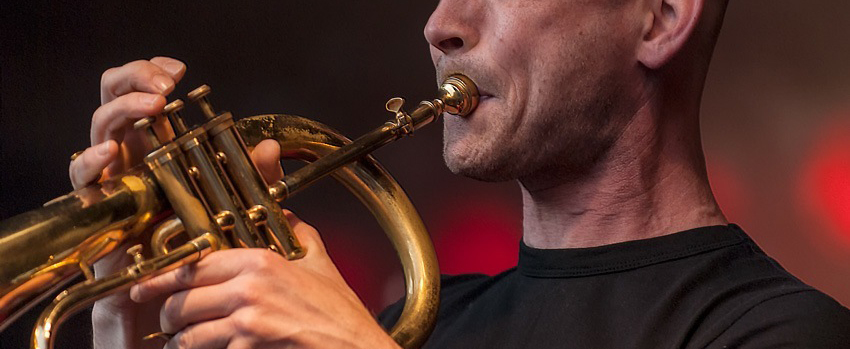This is part of a larger Guide to Brass Instruments:
- Introduction
- Brass Instrument Materials
- What Makes a Brass Instrument a Brass Instrument?
- Brass Instrument Family: Trumpets, Flugels, Cornets
- Brass Instrument Family: French Horns, Trombones, Low Brass
Defining the Term ‘Brass Instrument’
Why are instruments like saxophones called ‘woodwinds’ even though they are made from brass? Why are alpenhorns considered ‘brass instruments’ even though they are made from wood?
It comes down do how an instrument is played. An enormous classification of musical instruments called the Hornbostel-Sachs system was developed in the early 1900s. Click here to read my full article about this system. For this post, I will keep it simple and list the three top-level classifications which cover all brass and woodwind instruments:
Brass Instruments: the player’s vibrating lips set the air in motion.
Woodwind instruments: the player’s breath is directed against a lamella (a thin layer e.g. a reed) or pair of lamellae which periodically interrupt the airflow and cause the air to be set in motion.
Flutes (also considered woodwinds based on flutes being historically wooden): the player makes a ribbon-shaped flow of air with his/her lips or his/her breath that is directed through a duct against an edge.
 These are representations of the three classifications of playing which cover all woodwind and brass instruments (more or less)
These are representations of the three classifications of playing which cover all woodwind and brass instruments (more or less)
Thus, it is the way you play an instrument that makes something a ‘brass instrument,’ not the material used in its construction.
Brass Spotting Techniques
If you travel to the right location you may be lucky enough to see a brass instrument in its natural habitat. The image below is the best shot we have of a rare tuba native to the Welsh Highlands.

The instruments you are likely to come across in the wild – e.g. trumpets, cornets, horns, tubas – are all essentially long pipes that have been twisted into manageable shapes of fancy, expensive plumbing.
Each twisted pipe is played on a mouthpiece specific to that instrument. French horn mouthpieces are dainty and tapered while tuba mouthpieces are chunky and bulbous. The mouthpieces exist to collect the buzz made by the lips of players. The buzz is then channelled through the fancy plumbing until it becomes either music or something vaguely resembling music.
Pushing the buttons or levers on a brass instrument will redirect the flow of air into a longer piece of tubing. This effectively lengthens the horn and allows different tones to be made. With a combination of lip buzzing strength and button mashing you can get a full chromatic range of notes with just three or four buttons.
Valve Types
Valves are what move inside brass instruments when you push buttons or pull levers. There are two main types that will be mentioned throughout this guide: piston and rotary:
- Pistons move up and down. This results in very definitive note changes and is great for fast passages of music.
- Rotary valves swivel 90 degrees and result in a smoother, mellower transition between notes. This is good for expressive melodic pieces.
The passage of air will be slightly blocked if the felts on your valve are the wrong thickness. The same goes for the thickness of the rubber stoppers on rotary valves. This can result in an instrument feeling stuffy or resistant.
 Left: Piston / Right: Rotary
Left: Piston / Right: Rotary
Image from Yamaha
You Will Get Wet
It is important to understand the following basic principle: if you are blowing into something, then you are blowing moisture in as well. Brass instruments all have ‘water keys’ which is a polite name for spit valves.
The pools of your spit accumulate in various folds of tubing and need to be emptied out occasionally. If you do not drain the spit, you will start to hear weird gluggly slurpy sounds in your playing. It is nasty, but if elegant orchestral players in tuxedos and ball gowns can gleefully blast their spit onto the floor, so can you.

Water keys left to right: Amado; Saturn; Standard
Each style has its own merits. We have all available to fit at Vanguard Orchestral


